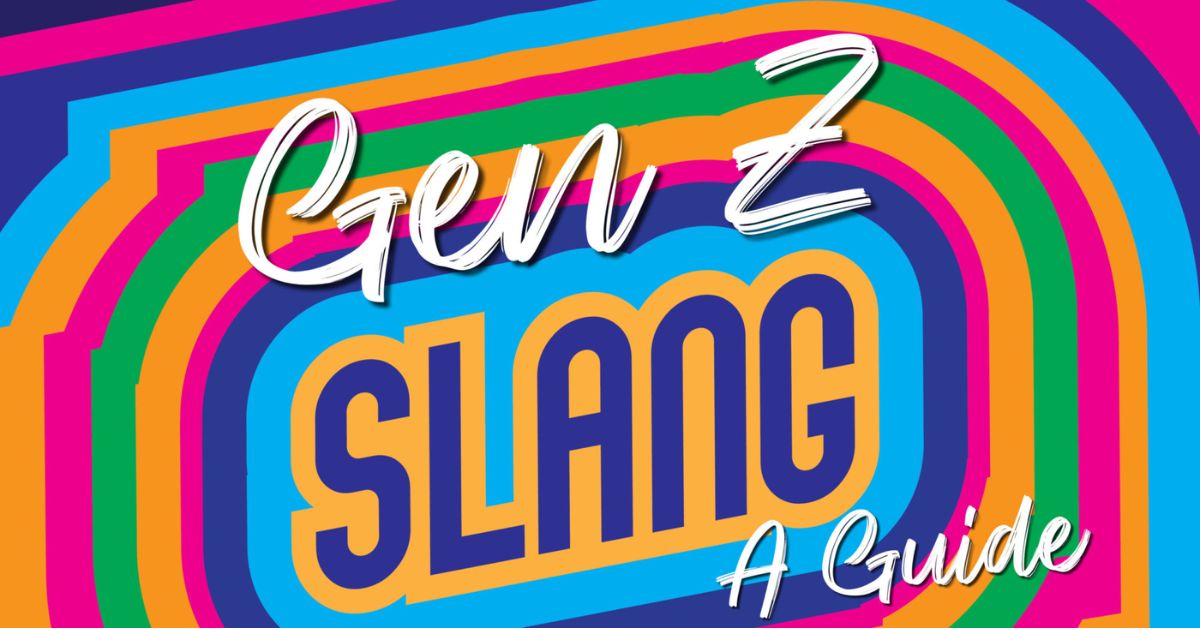In the rapidly evolving digital realm, a new linguistic phenomenon has emerged – the rise of Gen Z slang. These quirky, often perplexing terms have infiltrated our daily conversations, leaving many scratching their heads, wondering, “What did they just say?”
From the cryptic “yeet” to the empowering “woke,” this guide aims to demystify the lingo that defines a generation. Whether you’re a bewildered millennial, a curious Gen Xer, or a Gen Zer seeking to solidify your street cred, buckle up for a journey through the linguistic labyrinth of trendy slang.
Why Learn Gen Z Slang? The Importance of Trendy Linguistics
Mastering Gen Z vernacular goes beyond mere linguistic curiosity. It serves as a bridge, connecting generations and fostering understanding in an age where communication gaps can seem insurmountable. By decoding these terms, you gain insight into the cultural context, undertones, and mindset that shape the way young people perceive and interact with the world.
Moreover, speaking the language of the moment can be a powerful tool for appearing hip, relatable, and in-the-know. In both personal and professional settings, a well-timed use of Gen Z slang can establish rapport, build connections, and demonstrate your cultural awareness.
For instance, imagine you’re a marketing professional trying to connect with a younger demographic. Incorporating terms like “lit” or “snatched” into your campaigns could resonate deeply with your target audience, showcasing your understanding of their cultural landscape and increasing the likelihood of engagement.
More Post:
Today’s Jowai Ladrymbai Teer Result Common Number – 02 December 2022
The Origins and Evolution of Gen Z Vernacular
Gen Z slang didn’t emerge in a vacuum; it’s a product of the digital age, shaped by the constant influx of technology and the ever-evolving dynamics of social media. With information spreading at unprecedented speeds, a term can go viral and become ingrained in the zeitgeist almost overnight.
“Language is the road map of a culture. It tells you where its people came from and where they are going.” – Rita Mae Brown
This quote aptly captures the fluid nature of Gen Z vernacular. Unlike previous generations, where slang terms often had more static and localized origins, today’s lingo is a constantly remixed fusion of existing terms, Internet subcultures, and pop culture references.
Furthermore, the rise of visual culture – emojis, memes, and viral videos – has profoundly impacted the way Gen Z communicates, giving birth to a shorthand slang that transcends traditional linguistic boundaries.
1. Lit
The term “lit” has risen from its humble origins of describing a brightly illuminated place to become a resounding endorsement of anything exceptionally good, exciting, or lively. When something is truly remarkable, it’s “lit” – the ultimate compliment of the moment, signifying an experience that ignites excitement.
According to cultural commentator Dr. Jessica Taylor, “When something is truly remarkable, it’s ‘lit.’ It’s the ultimate compliment of the moment, signifying an experience that ignites excitement.”
2. Ghosting
In the digital age, the phenomenon of “ghosting” has become a modern social dilemma. It captures the essence of an individual suddenly cutting off all communication with someone else, leaving without a trace or explanation. This term is particularly prevalent in the realms of dating and friendships, where ending contact can be as easy as not responding to texts or blocking someone on social media.
Dr. Samuel Richards, a psychologist specializing in digital communication, notes, “Ghosting reflects the transient nature of modern relationships where connections, often formed quickly and superficially online, can be equally swiftly and silently dissolved.”
3. Tea
“Tea” in Gen Z slang is synonymous with gossip or juicy news. It stems from the tradition of sharing intriguing stories over a cup of tea, embodying the social enjoyment found in exchanging the latest information or secrets.
As sociolinguist Dr. Linda Greene explains, “The term ‘tea’ is central in conversations among youth, symbolizing not just the act of gossiping but also a communal experience that deepens bonds between friends.”
4. Woke
The term “woke” has transcended its origins in African American Vernacular English to become a pivotal part of modern vocabulary, particularly among Gen Z. It signifies a heightened state of awareness about social injustices, inequalities, and critical social issues affecting marginalized communities.
“Being ‘woke’ is much more than a mere buzzword; it embodies a conscious decision to challenge systemic issues and advocate for equality,” explains Dr. Karen Thompson, a sociologist specializing in social movements.
5. Flex
To “flex” is to deliberately showcase one’s accomplishments, possessions, or lifestyle, especially through social media, as a form of boasting or displaying one’s status. This term reflects the competitive digital culture where personal achievements and material success are publicly celebrated.
As Dr. Emily Larson, a psychologist who studies social media behaviors, notes, “Flexing is essentially a way of curating one’s public image, which for Gen Z, can be a strategic form of self-branding.“
6. Yeet
The term “yeet” embodies a dynamic expression of enthusiasm, approval, or the forceful act of throwing something. Originating from a viral dance move that involved a powerful throwing gesture, “yeet” has evolved into a multi-use exclamation within Gen Z’s vocabulary.
“The versatility of ‘yeet’ reflects its playful roots and how Gen Z adapts language to suit diverse emotional expressions,” explains Dr. Marcus Young, a cultural linguist.
7. Stan
Originally derived from the Eminem song of the same name, “stan” has become a term used to describe an extremely devoted fan, particularly of celebrities or public figures. It blends the elements of ‘stalker’ and ‘fan,‘ initially indicating an obsessive type of fandom.
However, as Dr. Helen Brooks, a sociologist studying fan culture, notes, “To ‘stan’ someone is to support them unwaveringly, often being vocal about one’s loyalty on social media platforms.” It reflects the deep engagement and loyalty Gen Z fans feel towards those they admire.
8. Snatched
“Snatched” is a term that has taken on new life within Gen Z slang, used to describe anything that looks exceptionally good or perfectly executed, especially in terms of fashion or appearance. Initially derived from drag culture, where it referred to a meticulously perfect visual presentation, the term now transcends various aspects of style and beauty.
According to fashion historian Dr. Laura Kim, “When someone or something is ‘snatched,’ it means they are looking their absolute best, often in a way that demands attention.” It’s a compliment of the highest order in Gen Z’s lexicon, applauding someone’s ability to look stunning or put together an outfit that is on-point.
9. Lowkey
The term “lowkey” is used to describe actions, feelings, or attitudes that are subtly expressed or kept understated. In Gen Z’s vernacular, “lowkey” often denotes a preference or desire that someone might want to downplay rather than openly celebrate.
As Dr. Anna Patel, a psychologist focusing on youth culture, notes, “‘Lowkey’ reflects a nuanced way of sharing one’s feelings without appearing too vested or enthusiastic, aligning with the contemporary youth’s preference for moderated emotional expression in public or digital spaces.”
10. Salty
Feeling “salty” is akin to being irritated, upset, or bitter, usually about something relatively minor but annoying. This slang term captures a reactive emotion that is less about deep anger and more about displaying momentary annoyance or dissatisfaction.
As Dr. Simon Clarke, a social psychologist, explains, “Salty brings a playful tone to expressing discontent, allowing young people to laugh at everyday frustrations and minor grievances.”
11. FOMO
“FOMO,” or the Fear Of Missing Out, captures a particularly modern anxiety associated with being absent from enjoyable or interesting events, especially those documented on social media. This term describes the apprehension that others might be having rewarding experiences from which one is absent, leading to feelings of anxiety and sometimes loneliness.
According to Dr. Rebecca Moore, a sociologist specializing in digital society studies, “FOMO is significant in understanding social dynamics among young people today, highlighting how digital connectivity impacts their emotional well-being.”
12. Skrrt
The term “skrrt” is an onomatopoeic expression that mimics the sound of screeching tires, typically used to denote a quick exit or a sharp change in topic or action. It captures a sense of abruptness and swift movement, often used humorously among Gen Z to inject a dynamic flair into conversations.
As Dr. Jordan Li, a linguist specializing in contemporary slang, explains, “‘Skrrt’ represents the agility an
13. Fire
Describing something as “fire” is a way to acknowledge its superior quality or attractiveness, indicating that it is exceptionally good, exciting, or trendy. This slang term is commonly applied across various contexts, from complimenting a stylish outfit or a skillful performance to lauding a delicious dish or an engaging piece of music.
“When Gen Z says something is ‘fire,’ they are marking it as top-tier, worthy of attention and admiration,” notes cultural commentator Dr. Mia Foster. It’s a stamp of approval that signals peer recognition and is often used to express personal enthusiasm and approval in a concise, emphatic manner.
14. Savage
The term “savage” in Gen Z slang denotes someone who acts with exceptional fierceness, boldness, or a sharp wit, especially in response to challenges or during confrontations. It often carries a positive connotation, celebrating someone’s ability to respond with unfiltered honesty or to cleverly put someone in their place.
As Dr. Lisa Horowitz, a psychologist focused on adolescent behavior, explains, “This usage of ‘savage’ applauds the assertiveness and confidence necessary to navigate social interactions today.” It praises the strength and resilience required to stand up for oneself or to make a point with undiluted clarity, often in a way that others find relatable or compellingly bold.
15. Mood
The term “mood” in Gen Z slang captures a relatable emotion or situation, serving as an immediate, empathetic acknowledgment of shared feelings or experiences. It is often used in response to images, videos, or statements that resonate on a personal level, succinctly expressing a sense of identification or agreement.
“When someone labels something as a ‘mood,’ they’re essentially saying it reflects their current state of mind or emotional condition,” explains Dr. Evelyn Carter, a psychologist specializing in social media interactions. This term simplifies complex emotions or reactions into a single word, facilitating a quick connection among peers in digital conversations.
16. No cap
The phrase “no cap” is frequently used by Gen Z to signify that they are speaking with complete honesty, without any exaggeration or deceit. It is a direct assurance to the listener that the speaker is being truthful, and there is no hidden meaning or falsehood behind what is being said.
The term is particularly useful in digital communication, where it can be challenging to convey sincerity. It serves as a reassurance that one is not ‘capping,’ a slang for lying, thereby fostering a sense of trust and authenticity in conversations, both online and in person.
17. Vibe Check
A “vibe check” is an expression used by Gen Z to quickly assess the general emotional atmosphere of a particular setting or the emotional state of a person. This informal check helps ensure that everyone in the group feels comfortable and the environment is conducive to positive interactions.
It’s a community-focused practice that values emotional intelligence and the well-being of each member, allowing for a harmonious and supportive environment. As Dr. Helen Brooks, a sociologist explains, “By performing vibe checks, young people actively work to maintain a positive group dynamic and address any discomfort that might be present, promoting open and supportive communication.”
18. Bet
In Gen Z slang, “bet” is a term of agreement, acknowledgment, or approval. It can be used as a response to a proposal or a statement, indicating acceptance and readiness to proceed. The usage of “bet” reflects a casual yet affirmative reply, similar to saying “sure,” “okay,” or “yes.” It is concise and effective in conveying consent and can also express enthusiasm or confidence about the upcoming action or event, showcasing a proactive and positive approach to engagements and opportunities.
19. Finna
“Finna,” a contraction of the phrase “fixing to,” is commonly used by Gen Z to express an immediate intention or the planning of an action in the near future. This term reflects a sense of immediacy and determination, embodying a proactive attitude towards upcoming activities or responsibilities.
It’s particularly popular in casual speech and text communication, providing a quick and informal way to communicate plans and intentions, emphasizing a readiness and forward-looking perspective that is characteristic of today’s youth.
20. Slay
To “slay” in Gen Z terminology means to excel or dominate impressively in a particular field or activity. The term is often used to describe outstanding performances, stunning fashion choices, or any significant success where an individual excels. Slaying is about achieving greatness and standing out prominently in whatever one undertakes.
In the social media context, where personal achievements and aesthetics are frequently showcased, to slay is to earn admiration and recognition, affirming one’s ability to surpass expectations and shine in the public eye. It’s a powerful expression of success and competence, celebrating exceptional achievement and visible impact.
21. Clout
“Clout” refers to influence or power, particularly in the context of social media. For Gen Z, clout is often associated with the ability to sway public opinion or garner extensive attention online. It is about having a significant impact, whether through a large following, viral content, or recognizable presence across platforms.
Possessing clout means that one’s opinions, styles, or decisions are influential enough to shape trends and discussions. This can lead to further opportunities, such as partnerships with brands, invitations to exclusive events, or simply the social prestige of being recognized as an influencer. Clout is highly valued among young people today as it represents a form of capital that can be leveraged in various aspects of life, including career and social interactions.
22. Bop
A “bop” is a term used to describe a catchy, high-quality song that resonates well with listeners, compelling them to dance or engage actively with the music. For Gen Z, calling a song a bop signifies that it not only has a great melody and infectious rhythm but also holds a certain cultural or emotional significance.
A bop is the kind of song that people want to share and talk about, one that becomes a part of personal and collective memory. This label elevates a piece of music from simply being enjoyable to being an anthem of the moment, encapsulating feelings or experiences that are relevant to the youth. The term reflects the generation’s engagement with music as a medium for identity expression and social interaction, showcasing how deeply a good tune can resonate within their community and become a staple of their shared cultural experience.
23. On Fleek
The term “on fleek” originally gained popularity as a way to describe perfectly groomed eyebrows, but it has since broadened to refer to anything that is impeccably styled or presented. When something is “on fleek,” it is executed with precision and looks flawless, signaling that someone has put considerable effort into their appearance or presentation.
This could apply to fashion choices, makeup, a hairstyle, or even a well-arranged social media post. In Gen Z culture, where image and aesthetics hold significant sway, being “on fleek” is a compliment of the highest order.
It indicates that someone has not only met the expected standards but has exceeded them, achieving an aesthetic that is both admired and desired. The term embodies the generation’s appreciation for those who can express themselves with style and precision, celebrating meticulous attention to detail that stands out in a crowd.
24. Thirsty
In the vernacular of Gen Z, “thirsty” extends beyond a simple need for hydration to describe a desperate craving for attention, approval, or recognition, particularly in the realm of social media. It characterizes actions or behaviors that appear too eager to secure likes, compliments, or any form of acknowledgment from others.
This could involve frequent, perhaps overly curated posts on Instagram, dramatic tweets, or any social media activity that seems designed to attract notice and validation. The term often carries a slightly negative connotation, suggesting a lack of subtlety or authenticity in one’s efforts to gain social approval. However, “thirsty” also reflects the broader social dynamics of online interaction, where visibility and engagement are crucial. It highlights the intense competition for attention in digital spaces and underscores the fine line between sharing content to connect with others and doing so to seek validation.
25. Cancelled
In Gen Z parlance, to be “cancelled” means to withdraw social or public support for someone—typically a celebrity, influencer, or public figure—due to their objectionable behavior or controversial statements. This aspect of “cancel culture” involves a collective decision where individuals use their collective power to hold others accountable for actions deemed inappropriate or offensive.
This often results in significant consequences for the cancelled individual, ranging from a loss of followers and public influence to professional setbacks like losing endorsements or opportunities. The act of cancelling someone is not taken lightly and usually follows what is perceived as a serious violation of societal norms or ethics.
While some critique cancel culture as being too unforgiving, many see it as a necessary tool for societal progress and accountability, emphasizing that it empowers younger generations to influence and demand higher ethical standards from those in the public eye.
Tips for Learning and Using Gen Z Slang Naturally
Now that you’re armed with the definitions of some of the most popular Gen Z terms, it’s time to discuss how to incorporate them into your vocabulary seamlessly. Here are some tips to help you learn and use this dynamic lingo like a pro:
- Immerse Yourself in Gen Z Culture: Follow influential Gen Zers on social media platforms like TikTok, Instagram, and Twitter. Observe how they interact and communicate, and pay close attention to the slang terms they use and the contexts in which they are employed.
- Join Online Communities: Participate in online forums, subreddits, or Discord servers frequented by Gen Z individuals. This will allow you to engage in real-time conversations and gain a deeper understanding of how the slang is used in various situations.
- Listen and Learn: When interacting with Gen Zers, be an active listener. Pay attention to the slang terms they use, and make a mental note of the meanings and contexts. Don’t be afraid to ask for clarification if you’re unsure about a specific term.
- Start Slowly and Be Self-Aware: Incorporating too much slang too quickly can come across as inauthentic or forced. Start by using a few terms here and there in appropriate contexts, and gradually build up your repertoire as you become more comfortable.
- Read the Room: Slang is often situational, and certain terms may be more appropriate in certain settings than others. Be mindful of your audience and the context before using slang terms.
- Don’t Overdo It: While using slang can help you connect with Gen Z, overusing it can have the opposite effect. Strike a balance and use slang sparingly and appropriately to avoid sounding like you’re trying too hard.
- Have Fun with It: Slang is meant to be playful and expressive. Don’t take it too seriously, and feel free to experiment and have fun with the language.
Here’s a quick listicle of do’s and don’ts when using Gen Z slang:
Do’s:
- Research the meanings and contexts of slang terms thoroughly.
- Use slang in moderation and in appropriate situations.
- Be open to learning and embracing new slang as it emerges.
- Have a sense of humor and don’t take yourself too seriously.
Don’ts:
- Use slang terms incorrectly or out of context.
- Overuse slang to the point where it becomes excessive or grating.
- Judge or dismiss slang as “just a phase” or “improper language.”
- Force the use of slang if it doesn’t come naturally to you.
Slang to Watch For – Buzzing New Terms
The world of Gen Z slang is ever-evolving, with new terms emerging and gaining popularity at a rapid pace. Here are a few buzzing new slang terms to keep an eye on:
- “Cheugy”: This term, which gained traction in 2021, is used to describe someone or something that is no longer trendy or fashionable, often associated with outdated or try-hard styles or behaviors.
- “Main Character Energy”: This phrase refers to someone who carries themselves with an air of confidence and self-assurance, as if they are the lead character in their own life story.
- “Sliving”: A portmanteau of “slaying” and “living,” this term is used to describe someone who is excelling and thriving in various aspects of their life.
- “Core Memory”: Inspired by the Pixar movie “Inside Out,” this term refers to a particularly vivid or impactful memory that shapes a person’s identity or worldview.
- “Gaslight”: While not a new term, “gaslight” has gained renewed popularity among Gen Z, referring to the act of manipulating someone into questioning their own reality or perception of events.
By staying attuned to these emerging terms, you’ll be able to keep your Gen Z slang game strong and maintain your relevance in the ever-changing linguistic landscape.
Conclusion
In the fast-paced world of digital communication, staying on top of Gen Z slang is more than just a linguistic exercise; it’s a gateway to understanding and connecting with a generation that is shaping the cultural zeitgeist. From the empowering “woke” to the relatable “mood,” these terms offer insights into the mindset, values, and experiences of young people navigating a rapidly evolving world.
Embracing Gen Z slang is not just about appearing trendy or hip; it’s about building bridges, fostering understanding, and engaging in meaningful conversations that transcend generational barriers. Whether you’re a parent, an educator, a marketer, or simply someone who values staying culturally relevant, mastering the art of Gen Z lingo is a valuable investment in fostering connections and staying attuned to the pulse of our times.
So, go forth and “slay” your Gen Z slang game, but remember to do it with authenticity, respect, and a willingness to learn and adapt. Keep your eyes and ears open for new terms that emerge, and don’t be afraid to ask questions or seek clarification. After all, language is a living, breathing entity, and staying up-to-date with its evolution is the key to unlocking a world of deeper understanding and meaningful communication.
Stay tuned for more updates on the latest slang terms and trends from [Your Blog Name], where we’ll continue to decode the linguistic labyrinth of Gen Z and help you stay “lit” in the digital age.










